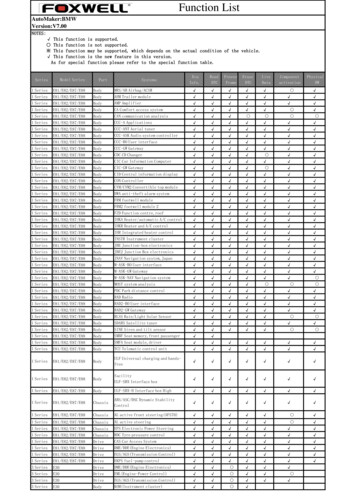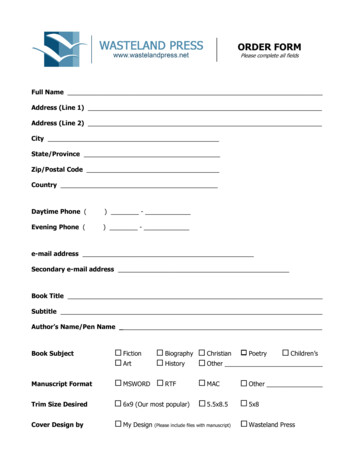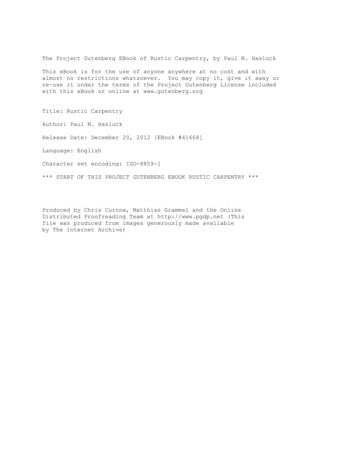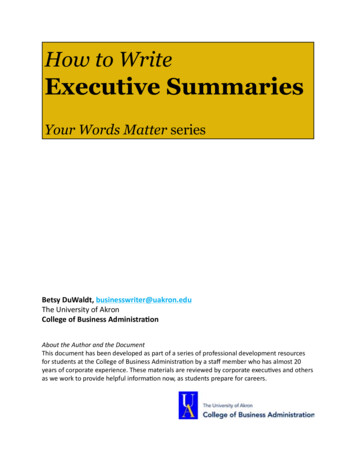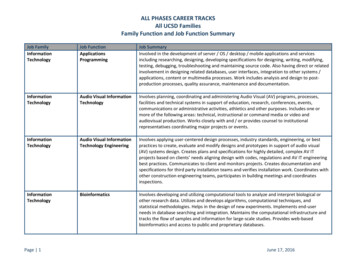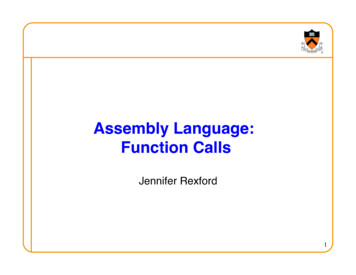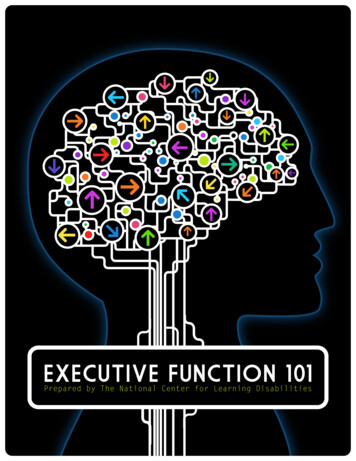
Transcription
EXECUTIVE FUNCTION 101Prepared by The National Center for Learning Disabilities
TABLE OFContentsSection Ip.3 IntroductionSection IIp.10 Executive Functionand LearningSECTION IIIp.21 Executive Function,Behavior and EmotionsSECTION IVp.25 Executive Functionin Social Situationsand RelationshipsWHYThis e-Book?Each of us navigates daily life — learning,work, recreation and relationships — thanks tointrinsic skills called executive functions.Children and adults with learning and attention issues—includinglearning disabilities (LD) and Attention-Deficit/Hyperactivity Disorder(ADHD)—often struggle profoundly with many of these skills that most ofus take for granted. To better understand and support your kids when theylack certain executive skills, it helps to know about the underlying brainfunctions that go awry to create such challenges.This e-book is designed to explain executive functions in a clear,understandable way and to help you pinpoint the struggles your child mightexperience. It’s organized into three broad categories where executive skillscome into play: learning; behavior and emotions; and social situations andrelationships. Each section includes tips for providing support and practicein specific skill areas. Even if your children don’t struggle with executivefunction, you may come to appreciate their executive skills and learn how tohelp them shore up those that need work!Executive Function 101 2
SECTION IWHAT ISEXECUTIVE FUNCTION?Executive function is a set ofmental processes that helps usconnect past experience withpresent action.People use it to perform activities such asplanning, organizing, strategizing, paying attentionto and remembering details and managing timeand space.These are skills and processes each of us useevery day to: Make plans Keep track of time and finish work on time Keep track of more than one thing at once Meaningfully include past knowledge indiscussions Evaluate ideas and reflect on our work Ask for help or seek more information when weneed it Engage in group dynamics Wait to speak until we’re called on Make mid-course corrections while thinking,reading and writingExecutive Dysfunction: Signs,Symptoms and StrategiesProblems with executive function (sometimescalled “executive dysfunction”) can run in families.Problems can be seen at any age but tend tobecome more apparent as children move throughthe early elementary grades. This is when thedemands of completingschoolwork independentlycan trigger signs of aproblem with executivefunction.There are no simpletests that identify all ofthe different featuresof executive function.Educators, psychologists, speech-languagepathologists and others use a variety of tests toidentify problems. Careful observation and trialteaching are invaluable in identifying and betterunderstanding weaknesses in this area.Your kids may have problems with executivefunction if they have trouble: Planning projects Comprehending how much time a project willtake to complete Telling stories (verbally or in writing),struggling to communicate details in anorganized, sequential manner Memorizing and retrieving information frommemory Initiating activities or tasks, or generatingideas independently Retaining information while doing somethingwith it, for example, remembering a phonenumber while dialingAs you’ll see throughout this e-book, there arespecific strategies you can use to help children withexecutive dysfunction overcome or compensate fortheir difficulties.Does Your Child Have ExecutiveFunction Difficulties?Executive skills develop gradually and atdifferent rates for different people. Most childrenstruggle at one time or another with planning,Executive Function 101 3
organization and followthrough. Learning and attentionissues, though, complicate thisdevelopment. Children with LDor ADHD nearly always havedifficulty with one or moreexecutive skills, which can leadto obstacles in learning andbehavior.IN THE PAST SIX MONTHS,This checklist willhelp you recognizeexecutive functiondifficulties in yourchild. Has trouble identifying where to start on assignmentsThis list does not diagnoseor pinpoint a specific problem,but it can be helpful as a wayto capture your observationsand concerns and start aconversation with your child’sschool personnel or otherprofessionals. Struggles to comprehend how much time a project will taketo completeMY CHILD. Has difficulty paying attention Is easily distracted Requires many reminders to stay on task Finds it difficult to set goals Seems to struggle with making decisions Focuses on either details or the big picture at the expense ofthe other Has difficulty getting started on tasks, often seems toprocrastinate Takes longer than peers to complete homework and othertasks Needs numerous prompts from adults to stay on task Loses track of time or assignment due dates Forgets to turn in completed work Struggles with keeping track of needed materials; oftenleaves materials at home or school Finds checking his/her work very difficult (and may not doit at all) Has trouble following multiple-step directions Forgets what he/she is saying or doing in the middle of atask Forgets the details of a text while reading or soon afterfinishing Gets frustrated with changes in schedule or usual routines Has difficulty shifting from one activity to another(especially when the rules/task demands change)On the next page,we’ll look at theoverarching executivefunction categoriesunder which thesebehaviors fall.This may help youbetter organize yourobservations. Struggles with shifting between information that is literalvs. figurative, past vs. present, etc. Gets stuck on parts of tasks and can’t move forward Seems to have difficulty controlling impulses—will say or dothings without thinking about them first Is easily frustrated Often talks out of turn and/or interrupts others’conversationsExecutive Function 101 4
EXECUTIVE FUNCTIONBEHAVIORAL CATEGORIESImpulse Controlthe ability to stop andthink before actingFor many children with ADHD,lack of impulse control is afundamental weakness. Theyoften say or do things withoutusing a cushion of time toreflect. They’ll do whateverpleasurable thing comes alongwithout considering theirobligations or commitments.Children with this weaknessoften speed through schoolwork,sacrificing accuracy andcompleteness along the way.FlexibilityEmotional Controlthe ability to managefeelings by thinkingabout goalsChildren who can’t manage theiremotions have trouble acceptingeven constructive criticism.They can’t keep their eyes ontheir goal when upsetting orunexpected things happen.They’re quick to call a situation“unfair.” They overreact tolosing a game or being calledon in class. They have difficultysticking with schoolworkwhen they’re distressed aboutsomething.Working Memorythe ability to changestrategies or reviseplans when conditionschangethe ability to holdinformation in mindand use it to completea taskChildren who behave in waysthat are inflexible have troublewhen a familiar routine isdisrupted or a task becomescomplicated. They get frustratedwhen a first attempt to solve aproblem isn’t successful. Theyare unable to see new ways todo familiar tasks or to makeanother choice when the firstchoice proves unworkable.Children with weak workingmemory are unable to rememberand apply crucial informationin order to move to the nextstep of a task. They falterwhen a task requires that theyremember a series of directions,generate ideas in response to thedirections and then express theirideas. Information just doesn’t“stick” for them.Planning/Prioritizingthe ability to createsteps to reach a goaland to make decisionsabout what to focus onChildren who have difficultyplanning and setting prioritiesare easily overwhelmed bycomplicated, multi-part tasks.They can’t independentlyimpose structure and orderon ideas. They have troublethinking through the stepsrequired to achieve a goal.They tend to underestimate aproject’s complexity and timerequirements.Self-Monitoringthe ability to monitorand evaluate your ownperformanceChildren who are weak atmonitoring themselves may notnotice that they’re not followingdirections until someone pointsthis out. They tend to misjudgetheir own efforts and havetrouble adjusting what they’redoing based on feedback orcues. They are often completelysurprised by a low grade on atest or project.Executive Function 101 5
Task Initiationthe ability torecognize when itis time to getstarted on somethingand begin withoutprocrastinatingChildren who are weak in thisskill have trouble startinghomework and put off projectsuntil the last minute. They’resometimes seen as lazy orunmotivated; keep in mind thatkids like this may procrastinatebecause they really don’t knowhow to start. Many children whohave difficulty getting startedalso have trouble with planningand organizing. They can getso overwhelmed by everythingthey have to do that they end updoing nothing at all.Organizationthe ability to createand maintain systemsto keep track ofinformation or materialsThis skill is closely tied toplanning, setting prioritiesand task initiation. Childrenwho lack organizationalskills lose permission slips,assignment sheets, notebooksand library books. They mayface consequences for beingdisorganized (for example, if theylose their homework, they get afailing grade) but don’t improvetheir organizational skills inresponse to these consequences.Children with poor skills in thisarea may understand the valueof organization but are unable tolearn how to keep track of things.Keep in mindthat progressin executivefunctioning isdevelopmental andvaries fromchild to child.Some kids will, through maturation, good teaching and trial and error,independently figure out ways to overcome or compensate for theirexecutive skills weaknesses. Most children with LD and ADHD, though, needextra support to develop or compensate for such deficits. The good news isthat you can help your children recognize, improve and work around theirareas of executive dysfunction.As schoolwork gets harder and students are asked to be more independent learners, children with weakexecutive skills fall further and further behind. Feeling anxious about what to do and how well they’re doing(especially when they’re “winging it” without a strategy or plan of attack) can easily lead to feeling overloadedand overwhelmed. This in turn leads to exhaustion, inattentiveness and a cycle of insecurity and feeling out ofcontrol. Not a great scenario for learning or self-esteem!Parents, in partnership with schools, can be enormously helpful in the improvement of children’s executiveskills. Because each child is on a slightly different developmental path and has a unique executive functionprofile, you’ll need to work with your child’s teacher to personalize strategies that will best address yourchild’s needs. Directly teaching your child these skills, offering frequent reassurance and giving clear, specificfeedback are all essential.Up next, enjoy our “Executive Function Around the Clock” illustration,which will take you through the challenging day of Josh, a sixth graderwho struggles with executive function.Executive Function 101 6
SECTION IIEXECUTIVE FUNCTION &LEARNINGThe Five Areas of Executive FunctioningAcademic success in our 21st-century schools is increasingly linkedwith children’s mastery of a wide range of skills that rely on their useof executive function strategies. The crucial role of executive functionprocesses begins in the preschool years and increases as studentsprogress through middle and high school when they’re expected tomaster complex skills that involve summarizing, note-taking andwriting. Each of the five areas of executive functionwill be explored inmore detail in the chapters that follow.Success depends on students’ ability to plan, organize and prioritizetasks, materials and information, separate main ideas from details, thinkflexibly, memorize content and monitor their progress. It’s important tohelp children understand how they think and learn and to teach them touse strategies in five major executive function blyAccessing WorkingMemorySelf-Monitoring/Self-CheckingThis infographic was adapted from a‘Clogged Funnel’ infographic created by ResearchILD.Executive Function 101 10
Long-term projects:Students need to keeptrack of many detailsand manage multipleelements of their projectssimultaneously. Studying: Students needto organize class notes,homework and othermaterials to prepare forORGANIZING &PRIORITIZINGOrganizing and Prioritizing areimportant executive functionsthat all of us use at work andin school.tests and quizzes. Organization involves arranging possessions,information or tasks into a structured whole sothat the parts are coordinated efficiently. As adults,we use a variety of organizational strategies andtools (e.g., calendars, file cabinets and computers)Writing: Students are required to producecohesive, integrated, analytical compositionsthat are well organized and prioritizeimportant details.Why Is Prioritizing Importantfor Academic Performance?to prioritize based on our goals and the level ofStudents who understand where to focus theirefforts on a given day or for a given task are ableto complete complex tasks with ease. Studentsneed to prioritize when they do the followingtasks.importance of the tasks. For example, we need to Juggle long-term and short-term tasks dayto day Select the most important information fornote-taking, studying or writing Manage the competing demands of school,homework and extracurricular activitieswithout losing track of important deadlinesto schedule and manage tasks and keep track ofimportant information. These techniques help usaccomplish tasks. As we organize, we also needselect which tasks to tackle first. Let’s look at howchildren call upon those same skills in school.Why Is Organization Important forAcademic Performance?From the early elementary grades to middleschool and beyond, the increasing demands ofthe curriculum and independent learning call forstronger organizational strategies.The key areas in which students faceorganizational challenges are: Homework: This requires students to writedown all assignments correctly, bring homematerials needed for their work, completetasks on time and remember to turn in theirwork.What About Children With LD andADHD?Of all the executive skills, organization andprioritization loom especially large, particularlyfor children with LD and ADHD. Disorganizedchildren with LD or ADHD are often calledlazy, unmotivated—even defiant. You may beone of the few people in your child’s life whounderstands how having a disability complicateshis or her ability to develop these skills.Executive Function 101 11
How Can Parents Help ChildrenOrganize and PrioritizeEffectively?Your child may understand the value of beingorganized but may not have the slightest ideahow to get that way. That’s where you can provideinvaluable assistance and encouragement. Thefollowing strategies can help children succeedwith academic and leisure activities and providea strong foundation for future performance asadults.Organizing Tasks project as a “mental movie” by breakingcomplex tasks into manageable chunks (likemovie scenes). Use a white board or sheet ofpaper to map tasks into flowcharts. time accordingly. You can teach your child to estimate the time each task will take andUse a family calendar to record importantcommitments. Weekly family meetings canhelp you coordinate everyone’s schedulesso that you model good planning andorganizational strategies.Help your child select calendars (paperor electronic) that can be updated withcommitments and tasks whenever you updatethe family calendar. Encourage your child toreview these calendars daily to anticipate newevents.Encourage your child to schedule fun activities(such as time with friends) along withimportant obligations.to track the time while working. Help kidsmake lists of homework assignments orchores. Let them experience the satisfactionof checking off tasks as they’re completed.Organizing Materials Technology-savvy middle and high schoolerscan try: An organized workspace helps children findthe materials they need for homework easilyand independently. Storing materials indifferent sections is helpful. For example, allwriting tools should be located together. Keep reference materials, includingcalculators, dictionaries and atlases, nearTECH-SAVVYOrganization TipsEncourage your child to write downimportant tasks in a calendar and to allocateOrganizing Time Teach your child to think of a long-termyour child’s homework workspace. Help kids identify a regular time duringthe week for clearing out and organizingFile-sharing software like Dropbox to keepnotes handy anywhere there’s an internetconnectiontheir backpack. Work together to make this Smartphone apps that serve as digitalsticky notes or bulletin boardshabit! Digital flashcards, also available as appson smartphones Password manager software to keep trackof passwordsa pleasant experience so that it becomes a Encourage them to use a brightly coloredfolder to bring important papers (likehomework and permission slips) to andfrom school, so those items don’t get lost.Executive Function 101 12
Prioritizing Tasks Help kids prioritize homework tasks based ondue dates, difficulty level or the level of stressthey have about the tasks. Encourage them to list the steps needed tocomplete long-term projects. Help them sequence tasks logically. Forinstance, before looking up vocabulary wordsin the dictionary, they could alphabetize thelist first. Partner with your child and the teacher.Collaborate to develop an organization systemthat works for your kids. Encourage them toexpress their opinions and preferences. Afterall, no organization method will work unlessyour child is willing to use it! Lead by (honest) example. Show yourchild the importance of organization in yourown life. Point out how a shopping list givesdirection to a trip to the supermarket. Ifyou rely on lists, a datebook or apps on yoursmartphone to stay organized, talk with yourchild about how your personal organizingsystem works (or falls short). Be honest aboutyour own organizational frustrations, so yourchild understands that organization is a skillthat many people—even adults—struggle tomaster. Create comfortable routines. All of usdevelop routines and habits to get us throughthe day. Your child will benefit greatly fromknowing what to expect during a typical schoolday and week. Keeping track of homeworkand assignments by writing in a planner everyday gives your child a visual reminder of whatneeds doing.Prioritizing Materials Teach kids to review homework and gathermaterials before starting work so thateverything is collected before they startworking. Store the most commonly used items withineasy reach in accessible locations.Keep It Simple, Relevant and RealHere are some general attitudes and approachesto keep in mind as you teach your child how toorganize and prioritize schoolwork and life ingeneral: Call upon your intimate knowledge ofyour kids—their personality, strengths andchallenges. Consider how your child thinks andworks. Focus first on short-term strategiesrelated to certain tasks or assignments. Start small. Help your child see that thesmallest improvements will make life easier. Keep it simple. Help your child be flexible,since children’s preferences change as doteachers’ requirements. Look for quick, easyways to begin organizing: a simple planner thatyou and your child check daily, a routine forfilling and emptying a backpack, a schedule fordaily homework, study and review.Relish the RewardsWith Your ChildStudents with LDand ADHD need extratime and practiceto develop theseskills. But once theylearn these habits,they’re rewardedwith greater successin school, more freetime to have fun—anda sense of pride andaccomplishment.Executive Function 101 13
Math competencyinvolves shiftingShifting/Thinking Flexiblybetween word meanings,procedures and operations. Science and historyrequire students to usecontext clues to prioritizeand focus on the mostCognitive flexibility, or theability to think flexibly and toshift approaches, is a criticalexecutive function for learningand succeeding in school. Students who have difficulty shifting also relevant information.Foreign language learning requiresstudents to shift between their nativelanguage and the language they are learning.Studying and test-taking requirestruggle to cope with unexpected changes in theirstudents to go back and forth between topicsschedules, routines or homework, and may beor problem types that are presented inviewed by their parents and teachers as “rigid,”different formats.“stubborn” or “single-minded.” Many childrenwith LD and ADHD have trouble thinkingflexibly.Why Is Flexible ThinkingSo Important for AcademicPerformance?As students advance through grade levels andthe curriculum becomes more complex, they mustbe able to interpret information in more than oneway and to change their approaches and strategieswhen needed. For example: Reading comprehension requires a studentto go back and forth between the major themesand supporting details and to sift and sortinformation while reading. Written language requires balancingimportant concepts and main ideas withWHAT ARE THEBenefIts ofBeing Bilingual?Scientists propose that a bilingualindividual uses “executive control”functions to separate the twolanguages.These executive functions are theabilities of the brain that we usefor things like higher-level decisionmaking, paying attention in acrowded coffee shop or figuring outlogic puzzles.So, as a bilingual person managestheir two languages, they areeffectively exercising these same brain“muscles.”the supporting details a student wants tocommunicate in writing.Executive Function 101 14
How Can You Help Your Child Becomea More Flexible Thinker?efficient. Multiple math formats help childrenrecognize that the presentation of problemsmay differ between class work, homework andtests. Encourage them to recognize the needto shift from one operation (e.g., addition) toa different one (e.g., subtraction). Have themask questions like: Do I know more than oneway to solve the problem? Does this looksimilar to anything I’ve seen before? Is thisproblem the same or different from the lastproblem?If your child needs help becoming a moreflexible thinker, you could try introducing thestrategies on the next page into daily activities athome, including homework and family (or solo)time. Activities that involve multiple-meaningwords, word categories and numberpuzzles can build a child’s flexible approachto language and numbers from the preschoolyears onwards.Visualizing and discussing jokes,riddles, puns and multiple-meaningwords can help children recognize thatambiguities in language can affect meaningand reinforce the importance of using contextclues when reading.Reading comprehension: When your kidscome across words or sentences they don’tunderstand, encourage them to stop readingand ask key questions such as: Is there a wordor phrase that could have more than onemeaning? Can I emphasize different parts ofthis sentence to change its meaning?Written language: If your child gets“stuck” on a writing task, encourage the useof strategies to organize and prioritize theinformation. Some tools that can assist in thisare graphic organizers to help children shiftbetween the main ideas and supporting details,and a three-column note-taking system torecord major themes, concepts or questions inthe first column, relevant details in the secondcolumn, and a memory strategy, such as apicture, in the third column. Studying for tests and quizzes: Showyour child how to extract and memorizeinformation from many sources, includingtextbooks, homework and notes. Help kidsrecognize that:··They need to study differently fordifferent kinds of tests. A multiplechoice test requires a focus on detailsand facts, but an essay question dependson telling the story rather than simplycramming in details.··Different study strategies may beneeded in different subject areas.For example, reviewing the major ideas innotes and textbooks is good preparationfor a history test, but class work and pasthomework assignments are more importantfor math.··With time, patience and practice, youcan help children become more flexiblethinkers, which will in turn help them learnmore and perform better in school.123Math: If kids try to solve math problemsin only one way, show them how to look foralternative approaches which may be moreExecutive Function 101 15
WorkingMemoryRemember the day when someonerattled off a phone number, andyou hoped you’d recall the stringof digits as you were dialing?“It’s likemental juggling.As informationcomes in, you’reprocessing it atthe same time asyou store it.”That was working memory, which plays a keyrole in learning in our daily lives. While workingmemory isn’t one of the executive functions, it’smuch like a foundation that supports the executivefunctions.If working memory is weak, it can trip up justabout anyone, especially a child with LD or ADHD.You can take steps to help a child with weakworking memory, whether or not learning andattention issues are part of the picture. First youneed to understand what working memory is andwhy it matters.What Is Working Memory?To understand what working memory is, seewhat a handful of experts have to say about it:Children use this skill when doing mathcalculations or listening to a story. They have tohold onto the numbers while working with them.They need to remember the sequence of events andalso think of what the story is about.Types of Working MemoryThere are two types of working memory:1. Verbal (auditory) working memorytaps into the sound (phonological) system.When kids have to follow a multi-step set oforal instructions, they’re using these working“Workingmemory isyour brain’sPost-itnote.”“It helps uskeep informationin mind while usingthat informationto complete a taskor execute achallenge.”“Brief bydesign, workingmemory involvesa short-term useof memory andattention.”Executive Function 101 16
memory skills. If there’s a weakness, however,they may not be able to keep the instructions inmind while working with them, even when theyfully understand what to do.Other tasks that require use of verbal(auditory) working memory are languagelearning and comprehension tasks. Auditoryworking memory usually affects learning morethan visual-spatial working memory because,since so much information is relayed verballyin school, it’s harder for students to easily findways to compensate for it.2. Visual- spatial working memory is like avisual sketchpad in the brain. It allows you toenvision something, to keep it in your “mind’seye.” Students use this skill to do math andto remember patterns, images and sequencesof events. They might use it to visualize theDifficulty with working memory may showup later in school, when executive skills ofcomprehension and analysis come into play. Asyou can imagine, then, if a child has a learningdisability, weak working memory can add insultto injury. For example, a fifth grader who’s stillsounding out words while reading is relying heavilyon working memory to help compensate. Thisputs a huge tax on the working memory system.At this stage, you want kids’ reading to be moreautomatic—for them to be able to look at a wordand recognize it without having to recruit attentionor working memory to do the task. So, for a childwho needs to compensate but can’t rely on workingmemory, the process can become all the morepainful.How Can You Identify WorkingMemory Problems?of this type is ripe for misunderstanding. ForTo figure out if your child has a problem withworking memory, first watch for signs (or askyour child’s teacher to do so). Kids with workingmemory problems could do the following.example, it might seem as though a child is Abandon activities before completing themsimply not paying attention. Appear to be daydreaming often Fail to complete assignments Raise their hands to answer questions butforget what they wanted to say (This is typicalfor a 5-year-old, but not for an 11-year-old, forexample.) Mix up material inappropriately—for example,combining two sentences Forget how to continue an activity that they’vestarted, even though the teacher has explainedthe stepslayout of the classroom during the first coupleof weeks of school. If not identified, a deficitHow Is Working Memory Linked WithLearning and Attention?Working memory can be a major problem forkids with ADHD, and those with weak workingmemory are likely to have LD, too.If you or your kids’ teachers have observedthese behaviors, perhaps consider formal testing.A school psychologist can assess both forms ofworking memory for your child.Executive Function 101 17
How to Help a Child With PoorWorking MemorySelf-Monitoring/Self-CheckingThere are lots of ways to help children withpoor working memory—from teaching themhow to compensate to lifestyle changes. Here aretechniques you can try (or share with your child’steachers to try): Know your kids’ weaknesses, but playto their strengths. If your child has strongvisual-spatial skills, try taking informationfrom a math word problem and inserting it intoa visual diagram. For instance, try using blocksor Legos to complete addition and subtractionproblems. Help compensate for a weakness. Breakup or chunk information. This takes up fewerSelf-monitoring is an executiveskill that requires students torecognize when and how to usespecific strategies, check theeffectiveness of these strategiesand adjust strategies in relationto the task at hand.“slots” in working memory. For example, giveone or two instructions rather than a longstring of them. If auditory working memoryis weak, don’t expect them to depend on it forimportant things. Encourage them to
child. This list does not diagnose or pinpoint a specific problem, but it can be helpful as a way to capture your observations and concerns and start a conversation with your child’s school personnel or other professionals. On the next page, we’ll look at the overarching execut
